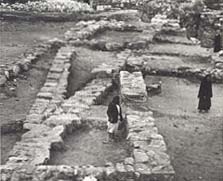Image Details

Courtesy Oriental Institute, University of Chicago
Repeated earthquakes at Megiddo necessitated the frequent rebuilding of the site’s stables (sometimes identified as storehouses) on top of rubble from earlier walls. Dating to the tenth century, the parallel walls running straight back may have been part of King Solomon’s stable. The diagonal walls running from the lower left date to about 1200 B.C.E.
The magnificent ninth-century B.C.E. stables, which accommodated about 450 horses (once identified as Solomon’s stables but now thought to belong to later kings, such as Ahab or Omri), originally stood on the remains of the tenth-century B.C.E. walls. In this photo, however, the ninth-century B.C.E. walls have been removed.
